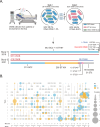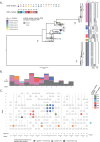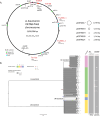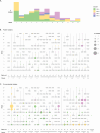Longitudinal genomics reveals carbapenem-resistant Acinetobacter baumannii population changes with emergence of highly resistant ST164 clone
- PMID: 39488505
- PMCID: PMC11531505
- DOI: 10.1038/s41467-024-53817-x
Longitudinal genomics reveals carbapenem-resistant Acinetobacter baumannii population changes with emergence of highly resistant ST164 clone
Abstract
Carbapenem-resistant Acinetobacter baumannii (CRAB) is a persistent nosocomial pathogen that poses a significant threat to global public health, particularly in intensive care units (ICUs). Here we report a three-month longitudinal genomic surveillance study conducted in a Hangzhou ICU in 2021. This followed a three-month study conducted in the same ICU in 2019, and infection prevention and control (IPC) interventions targeting patients, staff and the ICU environment. Most A. baumannii isolated in this ICU in 2021 were CRAB (80.9%; 419/518) with higher-level resistance to carbapenems. This was accompanied by the proportion of global clone 2 (GC2) isolates falling from 99.5% in 2019 to 50.8% (213/419) in 2021. The phylogenetic diversity of GC2 increased, apparently driven by regular introductions of distinct clusters in association with patients. The remaining CRAB (40.2%; 206/419) were a highly clonal population of ST164. Isolates of ST164 carried blaNDM-1 and blaOXA-23 carbapenemase genes, and exhibited higher carbapenem MIC50/MIC90 values than GC2. Comparative analysis of publicly available genomes from 26 countries (five continents) revealed that ST164 has evolved towards carbapenem resistance on multiple independent occasions. Its success in this ICU and global capacity for acquiring resistance determinants indicate that ST164 CRAB is an emerging high-risk lineage of global concern.
© 2024. The Author(s).
Conflict of interest statement
The authors declare no competing interests.
Figures





References
-
- Dijkshoorn, L., Nemec, A. & Seifert, H. An increasing threat in hospitals: multidrug-resistant Acinetobacter baumannii. Nat. Rev. Microbiol.5, 939–951 (2007). - PubMed
-
- Tacconelli, E. et al. Discovery, research, and development of new antibiotics: the WHO priority list of antibiotic-resistant bacteria and tuberculosis. Lancet Infect. Dis.18, 318–327 (2018). - PubMed
Publication types
MeSH terms
Substances
Grants and funding
LinkOut - more resources
Full Text Sources
Medical

